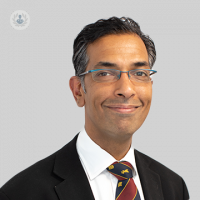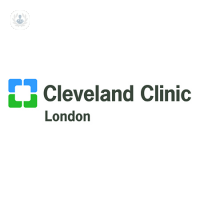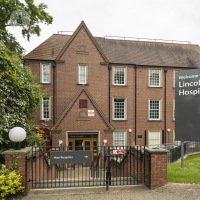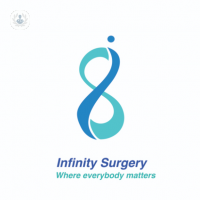What is laparoscopic hernia surgery?
Laparoscopic hernia repair is a minimally-invasive surgery performed with general anaesthesia. A laparoscope is a flexible, thin instrument with a light source and camera on the end. It is inserted through small incisions made in the abdomen, depending on where the hernia is. The surgeon is then able to use this camera to guide his surgical repair.
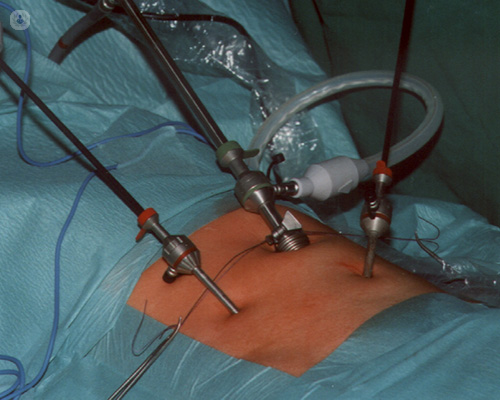
Why is it done?
Laparoscopic hernia surgery is less invasive than open surgery and leaves just three small scars instead of one large one. As a result, there is less pain following surgery and a quicker recovery period. Patients are able to return to normal activities sooner than after having open hernia repair surgery.
What does it involve?
During laparoscopic hernia surgery, the abdomen is inflated with carbon dioxide gas to allow a better view for the surgeon. The surgeon performs the repair of the hernia using stitches and synthetic mesh which provide reinforcement of the abdominal walls. Once repaired, the small incisions are closed with stitches or surgical tape. These stitches will dissolve over time and do not require later removal.
How do you prepare for laparoscopic hernia surgery?
Before laparoscopic hernia surgery is recommended by your specialist, you will have had a thorough physical examination, an MRI scan and an ECG to assess your cardiac health. You will also be given general anaesthesia for this surgery and you won’t feel anything during the procedure. As such, food, drink and certain medications will have to be stopped for a certain period before the operation.
Aftercare:
After laparoscopic hernia surgery, patients can normally return home the same day, providing they are not experiencing a lot of pain, nausea or vomiting. You can expect to be a bit sore for the first couple of days after surgery, but this can be managed with rest and painkillers. You should be able to walk around after surgery, working up to more strenuous activity slowly over the following two weeks. It is important to eat high-fibre foods during recovery to avoid constipation and straining on the toilet.
Alternatives to this treatment:
Hernias may also be repaired using open surgery or robotic repair surgery. Open surgery involves a larger incision being made to access the site of the hernia. The hernia is then pushed back into the correct position, reinforced with either stitches or synthetic mesh. Robotic repair is also performed laparoscopically, but the surgeons sits at a special console where they control the movements of the surgical instruments from this console.
07-06-2018 02-10-2023Riparazione di ernia laparoscopica
What is laparoscopic hernia surgery?
Laparoscopic hernia repair is a minimally-invasive surgery performed with general anaesthesia. A laparoscope is a flexible, thin instrument with a light source and camera on the end. It is inserted through small incisions made in the abdomen, depending on where the hernia is. The surgeon is then able to use this camera to guide his surgical repair.

Why is it done?
Laparoscopic hernia surgery is less invasive than open surgery and leaves just three small scars instead of one large one. As a result, there is less pain following surgery and a quicker recovery period. Patients are able to return to normal activities sooner than after having open hernia repair surgery.
What does it involve?
During laparoscopic hernia surgery, the abdomen is inflated with carbon dioxide gas to allow a better view for the surgeon. The surgeon performs the repair of the hernia using stitches and synthetic mesh which provide reinforcement of the abdominal walls. Once repaired, the small incisions are closed with stitches or surgical tape. These stitches will dissolve over time and do not require later removal.
How do you prepare for laparoscopic hernia surgery?
Before laparoscopic hernia surgery is recommended by your specialist, you will have had a thorough physical examination, an MRI scan and an ECG to assess your cardiac health. You will also be given general anaesthesia for this surgery and you won’t feel anything during the procedure. As such, food, drink and certain medications will have to be stopped for a certain period before the operation.
Aftercare:
After laparoscopic hernia surgery, patients can normally return home the same day, providing they are not experiencing a lot of pain, nausea or vomiting. You can expect to be a bit sore for the first couple of days after surgery, but this can be managed with rest and painkillers. You should be able to walk around after surgery, working up to more strenuous activity slowly over the following two weeks. It is important to eat high-fibre foods during recovery to avoid constipation and straining on the toilet.
Alternatives to this treatment:
Hernias may also be repaired using open surgery or robotic repair surgery. Open surgery involves a larger incision being made to access the site of the hernia. The hernia is then pushed back into the correct position, reinforced with either stitches or synthetic mesh. Robotic repair is also performed laparoscopically, but the surgeons sits at a special console where they control the movements of the surgical instruments from this console.


Incisional hernia repair surgery: All you need to know
Mr Dominic Coull
2024-12-31
Nowadays, hernia repair surgery is able to be performed both through minimally invasive and open procedures. In this article, highly esteemed consultant laparoscopic general and colorectal surgeon Mr Dominic Coull explains how incisional hernia repair surgery is performed, why it is necessary and how patients can expect to recover after undergoing the procedure. Mostrare di più
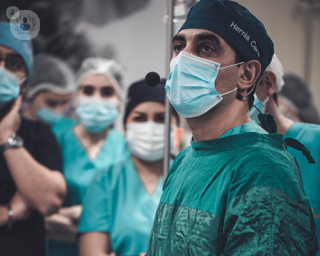

Laparoscopic hernia surgery: what to expect
Mr Noman Zafar
2024-12-31
A hernia is a great source of discomfort and potential complications. Laparoscopic hernia repair is a minimally invasive surgical technique used to fix hernias, offering many benefits over traditional open surgery. We speak to a revered consultant surgeon who discusses when laparoscopic surgery might be needed, how it's performed, and what you can expect from the procedure and recovery process. Mostrare di più


An essential guide to epigastric hernia repair
Mr Dominic Coull
2024-12-30
Mostrare di più
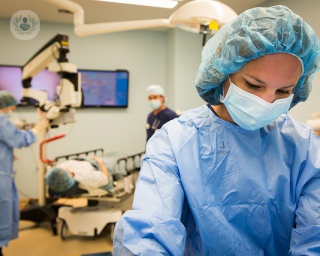

Laparoscopic hernia surgery: A modern approach
Mr Michail Klimovskij
2024-12-30
Hernias are a common surgical condition affecting millions of people worldwide. They occur when an organ or fatty tissue pushes through a weak spot or tear in the abdominal wall, leading to discomfort and pain. Traditional or open hernia repair technique, involving larger incisions and longer recovery periods, has been the standard approach for decades. In his latest online article, Mr Michail Klimovskij gives us his insights into laparoscopic hernia surgery which has improved the treatment of hernias, offering patients a minimally invasive alternative that promises faster recovery and reduced pain with desirable outcomes. Mostrare di più
Medici esperti in Riparazione di ernia laparoscopica
-
Mr Sakhawat (Zak) Rahman
Chirurgia generaleEsperto in:
- Colecistectomia
- Riparazione di ernia laparoscopica
- Chirurgia del pancreas
- Chirurgia dell'ernia inguinale
- Chirurgia dell'ernia iatale
- Chirurgia della cistifellea
-
Mr Michael Stellakis
Chirurgia generaleEsperto in:
- Riparazione di ernia laparoscopica
- Colecistectomia
- Colonoscopia
- Intestino irritabile
- Ernia
- Gastroscopia
-
Mr Gianluca Bonanomi
Chirurgia generaleEsperto in:
- Chirurgia bariatrica
- Chirurgia della cistifellea
- Chirurgia dell'ernia inguinale
- Riparazione di ernia laparoscopica
- Riflusso gastrico
-
Mr Bruno Sgromo
Chirurgia generaleEsperto in:
- Chirurgia gastrointestinale superiore
- Chirurgia bariatrica
- Chirurgia del cancro della pelle
- Chirurgia del cancro gastrico
- Complicazioni della chirurgia bariatrica
- Riparazione di ernia laparoscopica
-
Mr Shashank Gurjar
ColonproctologiaEsperto in:
- cancro colorettale
- Inflammatory bowel disease
- Malattie diverticolari
- Chirurgia delle emorroidi
- Chirurgia della fistola anale
- Riparazione di ernia laparoscopica
- Visualizzare tutti

Cleveland Clinic London Rapid Access Gallbladder Unit
Cleveland Clinic London Rapid Access Gallbladder Unit
33 Grosvenor Place
No existe teléfono en el centro.
Se utilizzi questo numero di Top Doctors autorizzi al trattamento dei dati a fini statistici e commerciali. Per maggiori informazioni, leggi la nostra l’informativa sulla privacy
Top Doctors

The Lincoln Hospital - part of Circle Health Group
The Lincoln Hospital - part of Circle Health Group
Nettleham Road, Lincoln, Lincolnshire, LN2 1QU
No existe teléfono en el centro.
Se utilizzi questo numero di Top Doctors autorizzi al trattamento dei dati a fini statistici e commerciali. Per maggiori informazioni, leggi la nostra l’informativa sulla privacy
Top Doctors

Infinity Surgery
Infinity Surgery
Nuffield Hospitals - North Staffordshire, Clayton Rd, Newcastle-under-Lyme ST5 4DB, United Kingdom
No existe teléfono en el centro.
Se utilizzi questo numero di Top Doctors autorizzi al trattamento dei dati a fini statistici e commerciali. Per maggiori informazioni, leggi la nostra l’informativa sulla privacy
Top Doctors
-
Cleveland Clinic London Rapid Access Gallbladder Unit
33 Grosvenor Place, Central LondonEsperto in:
- Analisi del sangue
- Chirurgia ad accesso minimo (chirurgia del buco della serratura)
- Chirurgia della cistifellea
- Chirurgia robotica della cistifellea
- Diagnostica per immagini
- Ecografía
-
The Lincoln Hospital - part of Circle Health Group
Nettleham Road, Lincoln, Lincolnshire, LN2 1QU , LincolnEsperto in:
- ecografia addominale
- Addominoplastica
- Ablazione con radiofrequenza
- Acne
- Angiologia e Chirurgia vascolare
- Vene del ragno
-
Infinity Surgery
Nuffield Hospitals - North Staffordshire, Clayton Rd, Newcastle-under-Lyme ST5 4DB, United Kingdom, Newcastle-under-LymeEsperto in:
- Acalasia
- Chirurgia bariatrica
- Chirurgia dell'ernia iatale
- Chirurgia della cistifellea
- Riflusso gastrico
- Riparazione di ernia laparoscopica
- Visualizzare tutti
- Trattamenti più letti
- Iniezioni di perdita di peso
- Secrezione dal capezzolo
- Dolori addominali nel bambino
- Chirurgia laser delle varici
- Chirurgia ad accesso minimo (chirurgia del buco della serratura)
- Il cancro della testa e del collo
- Collo
- Chirurgia bariatrica
- Matrice dermica acellulare
- Ricostruzione del seno prepettorale
